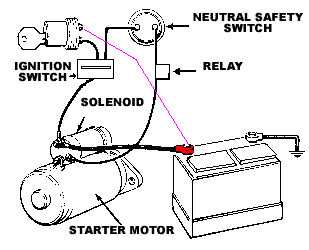Some would argue the most important part of the vehicle is the Starting System.
Without the ability to start your car it is pretty much unusable for transportation purposes. The Starting System starts with the battery. Without a fully charged battery the rest of the Starting System is worthless. Make certain the battery is fully charged, the battery connections are clean and the cable ends also clean. If there are any signs of corrosion in the battery cables them selves, you may want to replace the cables as it will pose an adverse affect on the Starting System

Neutral Safety Switch
This switch opens (denies current to) the starter circuit when the transmission is in any gear but Neutral or Park on automatic transmissions. This switch is normally connected to the transmission linkage or directly on the transmission. Most cars utilize this same switch to apply current to the back up lights when the transmission is put in reverse. Standard transmission cars will connect this switch to the clutch pedal so that the starter will not engage unless the clutch pedal is depressed. If you find that you have to move the shifter away from park or neutral to get the car to start, it usually means that this switch needs adjustment. If your car has an automatic parking brake release, the neutral safety switch will control that function also.
Starter Relay
A relay is a device that allows a small amount of electrical current to control a larger amount of current. An automobile starter uses a large amount of current (250+ amps) to start an engine. If we were to allow that much current to go through the ignition switch, we would not only need a very large switch, but all the wires would have to be the size of battery cables (not very practical). A starter relay is installed in series between the battery and the starter. Some cars use a starter solenoid to accomplish the same purpose of allowing a small amount of current from the ignition switch to control a high current flow from the battery to the starter. The starter solenoid in some cases also mechanically engages the starter gear with the engine.
Battery Cables
Battery cables are large diameter, multistranded wire which carry the high current (250+ amps) necessary to operate the starter motor. Some have a smaller wire soldered to the terminal which is used to either operate a smaller device or to provide an additional ground. When the smaller cable burns, this indicates a high resistance in the heavy cable. Care must be taken to keep the battery cable ends (terminals) clean and tight. Battery cables can be replaced with ones that are slightly larger but never smaller.
Starter Motor
The starter motor is a powerful electric motor, with a small gear (pinion) attached to the end. When activated, the gear is meshed with a larger gear (ring), which is attached to the engine. The starter motor then spins the engine over so that the piston can draw in a fuel/ air mixture, which is then ignited to start the engine. When the engine starts to spin faster than the starter, a device called an overrunning clutch (bendix drive) automatically disengages the starter gear from the engine gear.

Ask a Mechanic
Free Insurance Quotes
Car Owners Manuals
Auto Wiring Diagrams
Auto Repair Manuals
Auto Repair Estimates
Hybrid Cars
Nut & Bolt Measuring Charts
Mechanic's Lien Form






